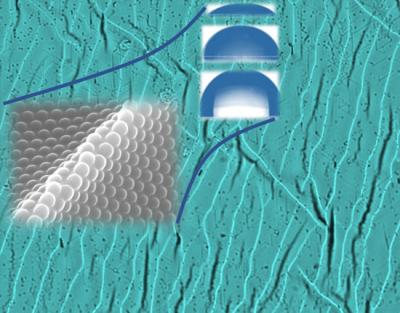
The buckling nature of pre-strained PDMS was applied to the investigation of the dependency of surface hydrophobicity on different geometries of wavy polystyrene thin films, which were fabricated using colloidal self-assembly. This approach can be further applied for fabricating various polymeric nano-films with controlled hydrophobicity.

Blake Stringer, Ph.D. (right), assistant professor of aerospace engineering in Kent State University's College of Aeronautics and Engineering, and research assistant Kendy Edmonds study the power needs for a new larger generation of drones, seen above, for a research grant funded by the Army Research Laboratory.

Comparison on phonon dispersion (a, b and c), measured lattice thermal conductivity versus prediction (d, e and f) and the corresponding error analyses (g, h and i) for Debye-Slack model (a, d and g), Debye-Snyder model (b, e and h) and the one developed in this work considering the periodic boundary condition (c, g and i) for crystalline solids.

The researchers' vision is of vehicles where a large part of the car-body or aeroplane-fuselage consists of structural lithium ion batteries. Multi-functional carbon fibre can work as battery electrodes and load-bearing material consecutively. The researchers work with structural lithium ion batteries where the negative electrodes are made of carbon fiber and the positive electrodes are made of cathode-coated carbon fiber. In the picture, the battery is charged, which means the negative electrode is filled with positively charged lithium ions.

The hot-press procedure, developed at Drexel, melts sulfur into the nanofiber mats in a slightly pressurized, 140-degree Celsius environment -- eliminating the need for time-consuming processing that uses a mix of toxic chemicals, while improving the cathode's ability to hold a charge after long periods of use.

MIT researchers have devised a way to grow single crystal GaN thin film on a GaN substrate through two-dimensional materials. The GaN thin film is then exfoliated by a flexible substrate, showing the rainbow color that comes from thin film interference. This technology will pave the way to flexible electronics and the reuse of the wafers.